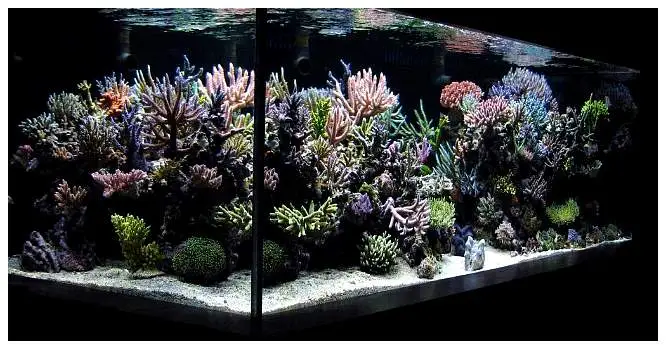Stunning 270-Gallon Reef Tank by Dave Jelley | ReefKeeping

Tank Specifications
Volume: 270 Gallons / 1021 Liters
Dimensions (L × W × H):
72.0" ×
36.0" ×
24.0"
182.9cm ×
91.4cm ×
61.0cm
Equipment List
No equipment information available
Frequently Asked Questions
How should I maintain water quality in my reef tank?
Maintain water quality using high-quality source water, such as utilizing an eight-stage water filter with RO/DI capabilities. Regularly check calcium and alkalinity levels, aiming for calcium around 400 ppm and alkalinity between 8-10 dKH. In a stable system, such checks might be done every few months, but keep an eye out for any signs of instability.
What filtration methods work best for a large reef tank?
For a 270-gallon reef tank, using a combination of biological filtration with live rock, a protein skimmer (like the Marine Technical Concepts HSA-1000), and mechanical filtration with 100-micron filter bags is effective. This combination helps keep the water clean and reduces organic buildup.
What is the best way to deal with nuisance algae?
To manage nuisance algae, ensure you have adequate water flow and quality, keep lighting suitable for your corals while avoiding excess, and consider having macroalgae in the refugium, which can outcompete unwanted algae for nutrients.
How can I avoid equipment failures that could damage my tank?
Regularly maintain all equipment, including skimmers and pumps, checking for clogs or malfunctions. Consider installing safety measures such as alarms for water levels and utilizing high-quality components to minimize risks.
What is the best way to clean the tank glass?
To keep your tank glass clean with minimal scratches, use a magnetic scraper daily, even if it does not appear dirty. This approach reduces the scrubbing required and helps to prevent scratches.
What is an effective feeding routine for my reef fish?
Feed fish high-quality foods such as Omega One™ flake food daily. Augment this with Cyclop-eeze™ or Golden Pearls™ two to three times per week, and use stick-on spirulina tablets for tangs to keep feeding clean and display-friendly.
How can I securely mount corals in my tank?
Use a coral pegging system to drill small holes into both the live rock and the coral base. Insert rigid tubing into the coral's hole and place it into the live rock, ensuring that corals remain secure and can be easily removed for maintenance.
What should I do if my corals are unhappy?
If corals seem unhappy, assess tank parameters such as water quality, light intensity, and flow rates. Consider relocating corals if they are not thriving in their current position or reaching for light, and ensure they receive adequate nutrition.
What lighting is recommended for a reef tank?
For a reef tank with corals, consider using metal halides combined with supplemental actinics. For example, three 400-watt 20K bulbs can provide good coverage, supplemented by actinic bulbs for additional spectrum, ensuring the light appears bright rather than overly blue.
How do I achieve proper circulation in my tank?
Use a combination of return pumps and closed-loop systems to achieve adequate flow. Aim for a turnover rate of about 25x the tank volume. Incorporating multiple intake and return points ensures even water movement throughout the tank.